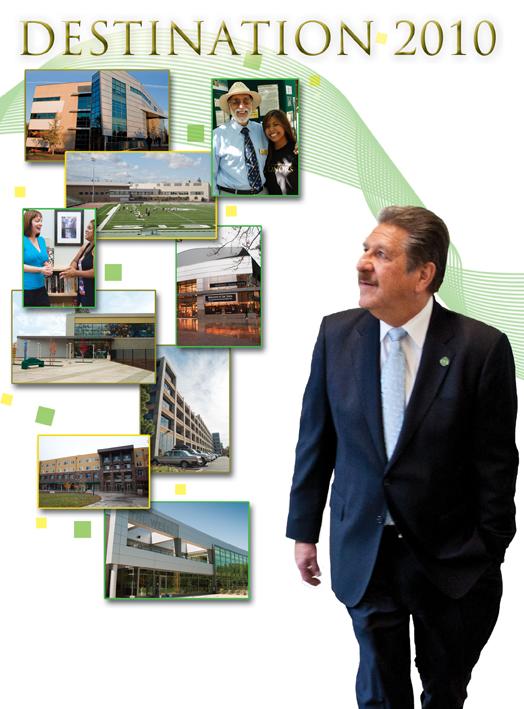Destination 2010: Success or failure?
Destination 2010 ::Graphic by Megan Harris – State Hornet Photos by Becky Bell, Robert Linggi, Dan Ward and Rachel Lotz
December 8, 2010
Six years after Sacramento State President Alexander Gonzalez unveiled Destination 2010, his pet project to foster the university’s prominence in the region, students and faculty have mixed feelings about the value it brought to campus.
Destination 2010, launched in 2004 during Gonzalez’s second year as president, is the initiative that brought student facilities such as the Well, the Academic Information Resource Center, the American River Courtyard residence hall and the 3,000-space Parking Structure III.
“It focused more on buildings than academics,” said Lois Boulgarides, president of the Capitol chapter of the California Faculty Association. “It was very cosmetic; all about branding and looks.”
From Boulgarides’ perspective, the rise in tuition, reduction of more than 300 faculty in the last two years, and the elimination of more than 220 class sections should be a rallying call for the university to re-prioritize scholastics.
“If there’s money to put up new buildings but not for basic academic programs, then there is something terribly wrong,” Boulgarides said.
But Destination 2010 had four goals &- one of which was to enhance academics. To that end, the university created a doctoral degree in educational leadership, the Guardian Scholars program for students who grew up in foster care, and the prestigious Capital Fellows program, a state government internship.
Campus officials also increased enrollment capacity for its nursing program and secured $500,000 in scholarships for its General Education Honors program.
“The criticism that we lacked focus on academics is totally false,” Gonzalez said.
Destination 2010’s other three goals were to create a welcoming campus, a dynamic campus and to elicit community support.
Bucking the naysayers was Associated Students Inc. President Terry Martin, who said Destination 2010 has helped make Sac State a place where students want to stay on campus.
“Students can go to the Well rather than buy a membership at 24-Hour Fitness, or go to the AIRC instead of going home,” Martin said. “It is really focused more on the student life aspect, and that’s something worthwhile. There’s much more to the student experience than academics, and being able to do things like work out at the Well can indirectly affect academic performance.”
Gonzalez, confidently backing his vision of university priorities, said Destination 2010 projects have brought donors to the university, which in turn helps students.
When billionaire philanthropist Eli Broad gave Sacramento State $2 million in 2006 to help build the Broad Field House, the university’s football and track facility, it was the first time he had donated to a California State University campus.
Gonzalez said Broad’s interest was directly correlated to an enhanced campus reputation carved out by Destination 2010 projects.
“All of these projects attract people and interest, and ultimately what we want them to do is support us financially as well,” Gonzalez said, citing several other examples.
The university’s fundraising arm, the University Foundation, in 2009 raised $150,000 for student veteran scholarships when the Veterans Service Center moved to a larger facility in the spring.
The university’s annual Green and Gold Gala used to bring in about $2 million to $3 million. But recently, the event has raised around $17 million, Gonzalez said, attributing the rise to donors’ increased interest in projects stemming from Destination 2010.
“Students are the beneficiaries,” Gonzalez said. “The vast majority of the money we raise is not in cash, but endowments to fund scholarships.”
But Boulgarides said there is no evidence that the Well itself, or any other Destination 2010 building, directly procured donations.
“There have always been people willing to donate money,” Boulgarides said. “They didn’t need three new buildings to have the Green and Gold Gala.”
Calling Gonzalez’ donation examples “a distraction,” Boulgarides said most donors help fund projects, buildings and stadiums, and not academic programs.
On several occasions since its inception, Destination 2010 has been controversial. Sac State’s auxiliary organization, University Enterprises Inc., purchased a building on Folsom Boulevard in summer 2007, previously owned by the California State Teachers Retirement System, to expand space for its nursing program.
But when UEI could not cover the rent, in part due to the declining economy, Sac State anted up $5.7 million for the lease.
The bailout exposed the university to questions about its financial relationship with the private auxiliary.
Destination 2010 is also, in all fairness, incomplete. Its original drawings included a new event center for concerts and sports, and a science complex slated to be built next to the Hornet Bookstore.
Gonzalez said the hurdles preventing completion were purely fiscal.
“With the economy the way it is, and the state budget the way it is, we don’t have the capital yet,” he said.
But there are still plans to complete those projects, Gonzalez said.
He said he will be unveiling his post-destination 2010 initiative this spring, which includes both projects.
“Destination 2010 was really the precursor to a much broader initiative that will take place over the next 10 to 20 years,” he said.
Looking back at his seven-year project, at times in the face of disapproval, Gonzalez maintains that Destination 2010 brought a new sense of pride to campus.
“When I first became president here, no one wore Sac State paraphernalia and clothing. But now you see it everywhere you go,” he said.
Ken Paglia can be reached at [email protected].







































































































































